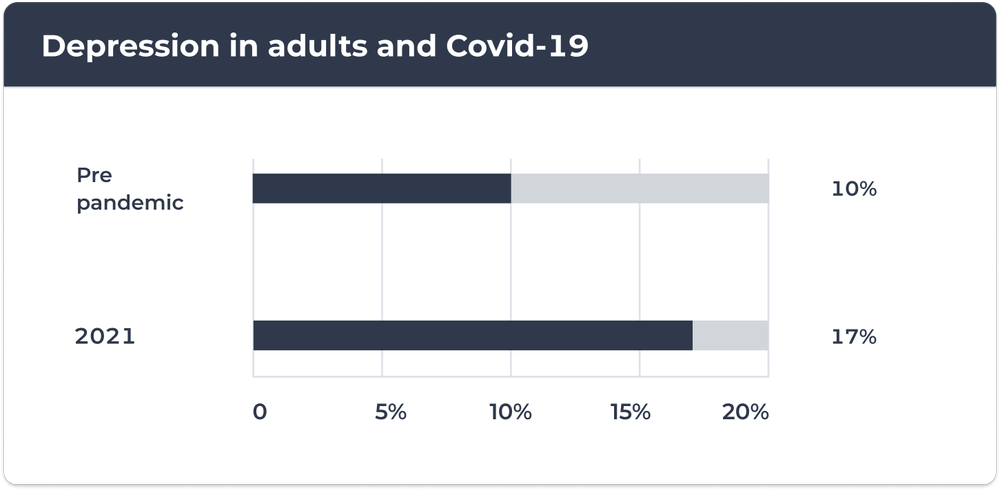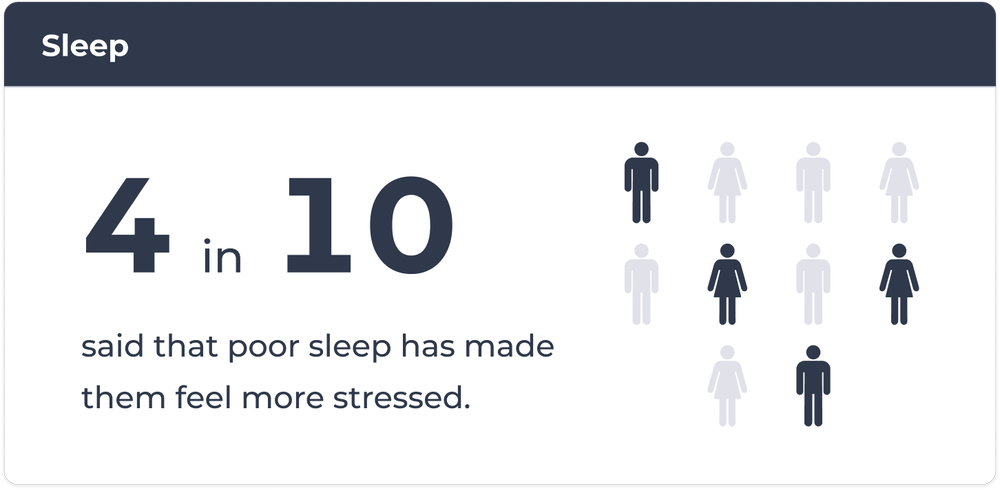Since the 2020 pandemic, poor mental health has been on the rise.
It’s now suggested that over 1 in 4 people will experience a mental health disorder each year in the UK. But, while so many suffer, funding and mental health services are still limited, with long wait times and limited treatment options.
The stigma around many mental health conditions remains and many aren’t able to get the help they need.
On this page, we’ve outlined UK-focused statistics of some of the most common mental health conditions.
In this article, you’ll find statistics for:
- Depression
- Anxiety and panic attacks
- Mental health trends
- Workplace mental health
- Loneliness
- OCD
- Borderline personality disorder
- ADHD
- Sleep
- Bipolar
- Schizophrenia
- Seasonal affective disorder
- PTSD and trauma
- Stress
- Self-harm and suicidal feelings

Depression
- Women are twice as likely as men to experience depression.
- 15% of women receive treatment for depression, compared to 9% of men.
- Depression rates in the UK are significantly higher due to the pandemic.
- Around 17% of adults in the UK experienced some form of depression in summer 2021, compared to just 10% before the pandemic.
- More than 264 million people suffer from depression worldwide (World Health Organization, 2020).
- Depression is the leading cause of disability in the world (World Health Organization, 2020).
Source: Champion Health



Anxiety and panic attacks
- Anxiety is the most common mental illness, affecting 40 million adults (19.1% of the population).
- Anxiety is a highly treatable disorder but only 36.9% receive treatment.
- Women are twice as likely to be affected by panic disorders than men.
- People with anxiety disorders are 3-5x more likely to go to the doctor and 6x more likely to be hospitalised for psychiatric disorders than those who don’t suffer from anxiety disorders.
Source: ADAA



Mental health trends
- 1 in 4 people will experience a mental health problem of some kind each year in England.
- 1 in 6 people adults experience a mental health issue, such as anxiety and depression, in any given week in England.
Source: Mind
- Mental health conditions increased from 17.4% in 2021 to 25.7% among 17 to 19 year olds, in 2022.
- In 2022, mental health conditions among 7 to 10 year olds was nearly twice as high in boys (19.7%) as in girls (10.5%).
- Mental health conditions among those aged 11 to 16 was nearly as high in boys (18.8%) and girls (22.0%).
- Among 17 to 24 year olds, mental health conditions were much higher in young women (31.2%) than young men (13.3%).
- Children with a mental health condition were more likely than those without to live in a home experiencing financial strain.
- Among 17 to 22 year olds with a mental health condition, 14.8% reported living in a household that was unable to buy enough food or used a food bank in the past year.
- 28.6% of 7 to 16 year olds with a mental health condition lived in households that experienced a reduction in household income in the past year.
- 13.6% of children with a mental health condition lived in a household where they could not afford to keep the house warm enough.
Source: NHS 2017
- 1 in 8 people in the world live with a mental health condition (World Health Organisation)

Workplace mental health
- 58% of employees are experiencing anxiety.
- Only 10% of employees are diagnosed with anxiety.
- 34% of employees experiencing anxiety are aged 25-34.
- 62% of employees experiencing anxiety are female.
- Only 9% of employees are seeking mental health support.
- Nearly 1 in 4 employees met the criteria for “clinically relevant symptoms” of depression and would benefit from support from a qualified mental health professional.
Source: Champion Health

- 40% of employee turnover costs are due to mental health issues.
- Presenteeism (attending work whilst ill) is the highest reason for staff turnover.
- 50% of employees experienced at least one symptom of burnout (feeling of exhaustion, mental distance from their job, or decline in performance at work).
- More than 36% of employees used mental health resources to help them manage their mental health.
- 61% of employees planned to leave their job due to poor mental health.
Source: Deloitte Mental Health Report 2022

- Men are less likely to seek professional support for mental health problems than women, just 28% of men access mental health support.
- 71% of people willing to talk to a mental health practitioner were women.
- The types of support accessed by those surveyed were fairly evenly distributed between a wide range of solutions: counselling (28%), therapy (26%), life coaching (23%), executive coaching (12%), mindfulness (8%) and psychology (3%).
- Non-traditional mental health offerings – life coaching, executive coaching and mindfulness – comprised a total of 46% of solutions accessed.
- 74% of respondents said they would take time off work without the mental health sessions.
- Of those accessing mental health sessions, an overwhelming 65% were aged 18-34 years old, compared to just 22% of 35-44 year olds, and 13% aged over 45 years old.
- MYNDUP’s approach has been proven to reduce stress, anxiety and depression in 97% of users and boost employee confidence, motivation and productivity in 99% of users.
Source: MYNDUP 2022


- 1 in 12 employees are currently experiencing thoughts of suicide or self-harm.
- Employees experiencing financial stress are twice as likely to experience thoughts of suicide or self-harm.
- 17 million working days were lost due to work-related stress, depression or anxiety in 2021/22.
- The total numb.er of cases of work-related stress, depression or anxiety in 2021/22 was 914,000.
- In 2021/22 stress, depression or anxiety accounted for 51% of all work-related ill health cases and 55% of all working days lost due to work-related ill health.
Source: ONS - Labour Force Survey




Loneliness
- 55% of London residents say they feel lonely, making London the loneliest city in the world.
- In the UK, statistics show that 14% of the population feels lonely all the time. Additionally, 36% of the population is too embarrassed to admit to feeling lonely during the holidays.
- 45% (25 million) of people in England feel lonely occasionally, sometimes, or often.
- Half a million older people go at least five or six days a week without seeing or speaking to anyone at all.
- 50% of disabled people will be lonely on any given day.
- Loneliness with severe depression is associated with early mortality and loneliness is a risk factor for depression in later life.
- People who say they “often” or “always” feel lonely has risen from 2.6 million people in 2020 to 3.3 million people as of February 2022.


Obsessive compulsive disorder - OCD
- Over 1.2% of the population in the UK have OCD.
- People with OCD experience repetitive and intrusive thoughts, and obsessions.
- There is currently the stigma that OCD is mild and quirky.
- Misconception that OCD simply means excessive hand-washing.
- Half the adults who have OCD, got it as a child but didn’t seek help due to embarrassment or stigma.
- Out of 500 young children, 5 will have OCD.
- Women are 3x more likely to be affected than men.
Source: Ocdaction

Borderline personality disorder
- BPD is a mental health condition that 1.4% of the population develops.
- BPD is diagnosed in people above 18 years old, sometimes as early as 12.
- 75% of BPD sufferers are women.
- 50% of people with BPD are likely to have abused substances within the previous year.
- Individuals with this disorder make up 20% of all psychiatric inpatients.
Source: MedAlertHelp
ADHD
- ADHD in adults is widely reported as between 2.5%-4% although this is felt to be a conservative figure.
- Only approximately 10-20% of individuals with ADHD will be treated.
- Although there's no direct cause for ADHD, it’s thought that genetic factors are responsible for 70%-80% of the probability.
- Up to 60% of adults who have childhood ADHD will continue to show symptoms into their adult life.
- In the UK it’s thought that between 2% to 5% of school aged children have ADHD.


Sleep
- 40% of people aged between 18 and 24 say that they struggle to fall asleep quickly.
- 33% of UK citizens above 55 years old say that they struggle to fall asleep fast.
- 51% of individuals aged between 18 and 29 reported getting at least 8 hours of sleep.
- 36% of the adults in the UK struggle to fall asleep at least once a week.
- St. Helens Hospital in the UK prescribed the most amount of insomnia medications.
- Walsall residents do searches for “can’t sleep” more than in any other region.
- 35% of individuals in the UK said lack of proper sleep made them anxious.
- 4 in 10 adults said that poor sleep has made them feel more stressed.
- 43% of UK citizens stated that poor sleep made them irritable or angry.
- 1 in 3 people in the UK are sleeping less than before the pandemic.
Source: CyberCrew




Bipolar
- 1 in every 100 people are diagnosed with bipolar disorder at some point in their life.
- Bipolar often develops between the ages of 15 and 19 and rarely develops after 40.
- 25–50% of people with bipolar disorder will attempt suicide.
- More than 1 million people in the UK are estimated to have bipolar disorder, which leads to extreme changes in mood and energy levels.
- The bipolar disorder suicide rate is about 11%.


Schizophrenia
- Schizophrenia affects approximately 24 million people or 1 in 300 people (0.32%) worldwide.
- People with schizophrenia are 2 to 3 times more likely to die early than the general population.
- Approximately 50% of people in mental hospitals have a schizophrenia diagnosis.
- Only 31.3% of people with psychosis receive specialist mental health care.
Source: World Health Organization



Seasonal affective disorder
- People that live in London are likelier to experience SAD than any other areas of the UK by 11%.
- Men are twice as likely to be diagnosed with SAD than women.
- Women suffer more with lower moods in Autumn and winter than men (18.28% women and 12.87% men).
- More than 1 in 20 people in the UK have been diagnosed with seasonal affective disorder.
Source: Micro Biz Mag



PTSD and trauma
- 60% of men experience at least one trauma in their lives, and 50% of women.
- The leading cause of PTSD is sexual violence at 33%, with 94% of rape victims developing symptoms of PTSD during the first two weeks after their traumatic experience.
- 30% of women raped still experience PTSD symptoms nine months after the incident.
- 75% of sexual assault survivors were diagnosed with PTSD a month after the incident. This drops to 54% after three months, and it further drops to 41% after a year.
- 6 weeks of cognitive behavioural therapy can help ease symptom severity by about 50% in 21% to 46% of patients with PTSD.
- 45 to 59-year-old adults are more affected by this mental illness than older adults above 60 years old.
- More women suffer from PTSD than men.
- People in the military are more prone to PTSD than civilians.
- PTSD is most common among individuals between the ages of 45 and 59 years old at 9.2%, compared to individuals above the age of 60 years old at 2.8%.
- Among adolescents, about 5% of those between 13 and 17 years old have PTSD.
- 30% of first responders have mental health problems such as PTSD, compared with the 20% of the general population.
Source: CFAH



Stress
- The most common cause of stress is work-related stress with 79% saying they frequently felt it.
- Women experience stress more frequently than men. On average, women in the UK say they feel stressed approximately ten days each month, whereas men say they experience stress for an average of seven days a month.
- One in 14 UK adults (7%) feel stressed every single day.
- 1 in 5 people in the UK feel stressed more days a month than they don’t.
Source: CIPHR
- 74% of people feel so stressed they have been overwhelmed or unable to cope.
- 46% of people say they eat too much or too unhealthily due to stress.
- 29% of people say that due to stress they started drinking or increased their drinking.
- 16% say that they started smoking or increased their smoking due to stress (Mental Health Foundation and YouGov).
- 51% of adults who felt stressed reported feeling depressed and 61% reported feeling anxious (Mental Health Foundation and YouGov).
- Of those experiencing stress, 16% had self-harmed and 32% said they had experienced suicidal thoughts and feelings (Mental Health Foundation and YouGov).
- 37% of adults who reported feeling stressed also felt lonely as a result (Mental Health Foundation and YouGov).
Source: Mental Health Foundation and YouGov



Self-harm and suicidal feelings
- Over 700,000 people take their own life each year – that’s one person every 40 seconds.
- 115 people die by suicide in the UK every week – with 75% of those deaths being male.
- 1 in 5 people have suicidal thoughts.
- 1 in 14 people self-harm.
- 1 in 15 people attempt suicide.
- Males aged 45-49 have the highest suicide rate.
- 10% of young people self-harm.




Summary
That’s it for the round up of mental health statistics. What stood out most to us is that the wait time for treatment in some areas of England was as long as 182 days.
We hope you find these statistics useful. Reach out to us and let us know what you think!

